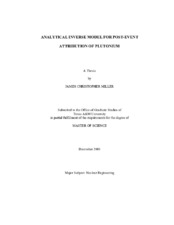| dc.description.abstract | An integral part of deterring nuclear terrorism is the swift attribution of any event
to a particular state or organization. By quickly being able to identify the responsible
party after a nuclear event, appropriate people may be held accountable for their actions.
Currently, there is a system in place to determine the origin of nuclear devices and
materials from post-event data; however, the system requires significant time to produce
an answer within acceptable error margins. Described here is a deterministic approach
derived from first principles to solve the inverse problem. The derivation starts with the
basic change rate equation and ends in relationships for important nuclear concentrations
and device yield. This results in a computationally efficient and timely method for
producing an estimate of the material attributes. This estimate can then be used as a
starting point for other more detailed methods and reduce the overall computation time
of the post-event forensics.
This work focused on a specific type of nuclear event: a plutonium improvised
nuclear device (IND) explosion. From post-event isotopic ratios, this method determines
the device’s pre-event isotopic concentrations of special nuclear material. From the original isotopic concentrations, the field of possible origins for the nuclear material is
narrowed. In this scenario, knowing where the nuclear material did not originate is as
important as knowing where it did.
The derived methodology was tested using several cases of interest including
simplified and realistic cases. For the simplistic cases, only two isotopes comprised the
material being fissioned. In the realistic cases, both Weapons Grade and Reactor Grade
plutonium were used to cover the spectrum of possible fissile material to be used by
terrorists. The methodology performed very well over the desired energy range. Errors
were under two percent from the expected values for all yields under 50 kT. In the
realistic cases, competing reactions caused an increase in error; however, these stayed
under five percent. As expected, with an increased yield, the error continued to rise, but
these errors increased linearly. A sensitivity analysis was performed on the
methodology to determine the impact of uncertainty in various physical constants. The
result was that the inverse methodology is not overly sensitive to perturbations in these
constants. | en |


